Princess Mary Village Homes Industrial School for Girls, Addlestone, near Weybridge, Surrey
In 1870, Mrs Susanna Meredith and Miss Caroline Cavendish founded the Farm House Home for the very young children of convicts. The two had previously been involved in working with discharged female prisoners and discovered how the children of such women suffered from the removal of their mothers. Their initial scheme to find foster homes for the children soon evolved into the setting up of the residential establishment, initially located at Essam Farm, near Chertsey. On August 12th, 1870, the home was certified as an Industrial School, an institution where, amongst other things, magistrates could place children under 14 whose mothers had been twice convicted of 'crime'. On March 24th, 1871, the home relocated to a house on New Haw Road.
In the meantime, plans were progressing to erect a permanent base for the establishment on a plot of land at Addlestone. Princess Mary Adelaide, Duchess of Teck, lent her support for the scheme which adopted the cottage homes model. On July 12th, 1871, the Princess cut the first turf on the site which would eventually include six pairs of cottages. A similar number of donors was found to fund the £300 cost of each pair. The institution was originally planned to be known as Mrs Meredith's Prison School and run in association with the Mission in Aid of Discharged Female Prisoners. A comment from Princess Mary about the inevitable stigma of having been to a 'prison school' eventually resulted in a change of name to the Princess Mary Village Homes for Girls. Following the completion of the first cottages, the existing inmates of New Haw Road moved into the new premises on March 22nd, 1872. The site had been officially certified for use as an Industrial School on 26th February. While the remaining cottages were being erected, a nearby house called Roselands was rented to provide further temporary accommodation. The homes could eventually accommodate 200 girls, aged from 1 to 10 years, with small boys also being admitted in exceptional circumstances.
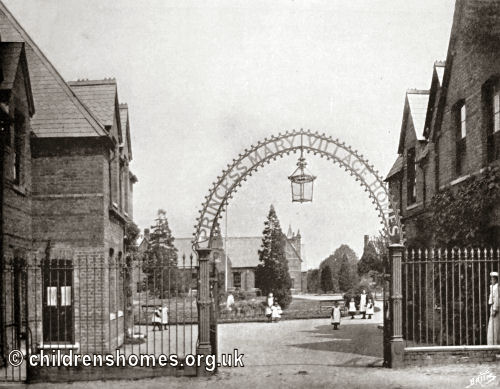
Entrance to Princess Mary's Village Homes for Girls, Addlestone, c.1905. © Peter Higginbotham
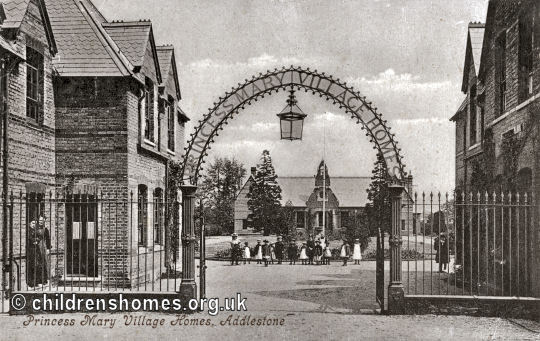
Entrance to Princess Mary's Village Homes for Girls, Addlestone, c.1905. © Peter Higginbotham
Each cottage included a kitchen, dining room, sitting room, toilet, locker room, and three girls' bedrooms. The girls were in the charge of a house matron who had her own sitting room and bedroom. Originally the homes had no mains water or electricity and each cottage was allowed a weekly ration of 1½ pounds of candles.
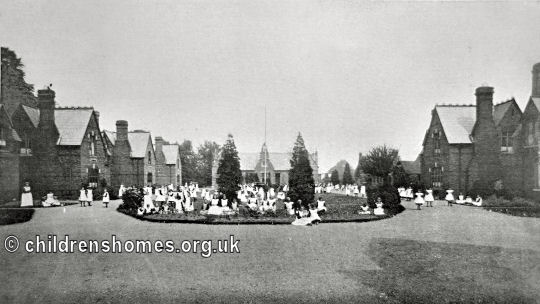
Princess Mary's Village Homes for Girls, Addlestone, from the west, c.1905. © Peter Higginbotham
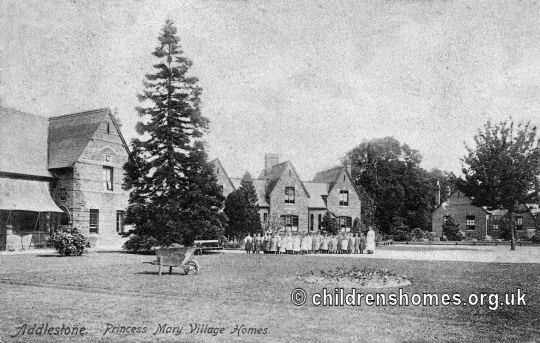
Princess Mary's Village Homes for Girls, Addlestone, c.1905. © Peter Higginbotham
Other buildings erected on the site included a school hall, teachers' quarters, chapel and an infirmary. A laundry was also set up, which not only did the homes' own washing, but also took in outside work from local households and generated some useful income. A donkey cart was acquired to help transport the laundry. The girls also learned to cook and to make stockings by machines.
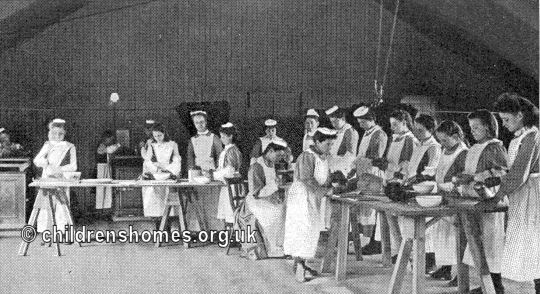
Princess Mary Village Homes for Girls, Addlestone — Learning to cook, c.1906. © Peter Higginbotham
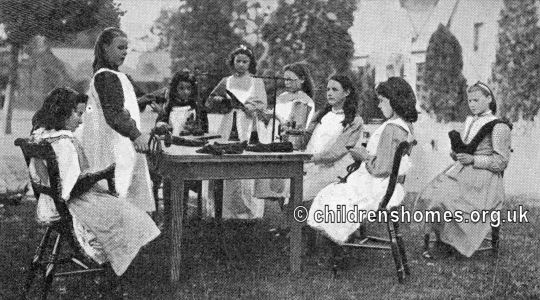
Princess Mary Village Homes for Girls, Addlestone — Making stockings by machine, c.1906. © Peter Higginbotham
Physical activities included formation-style drill.
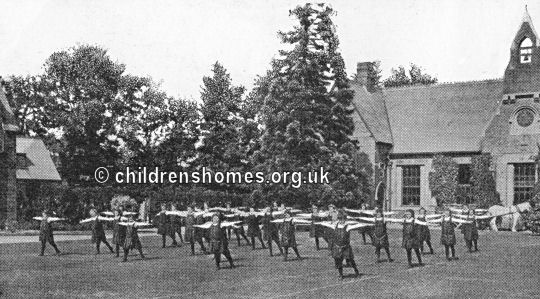
Princess Mary Village Homes for Girls, Addlestone — Girls at drill, c.1906. © Peter Higginbotham
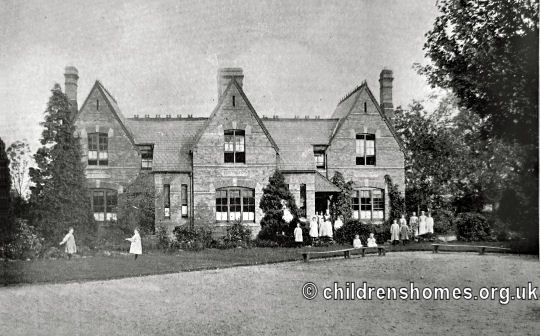
Princess Mary's Village Homes for Girls, Addlestone, c.1905. © Peter Higginbotham
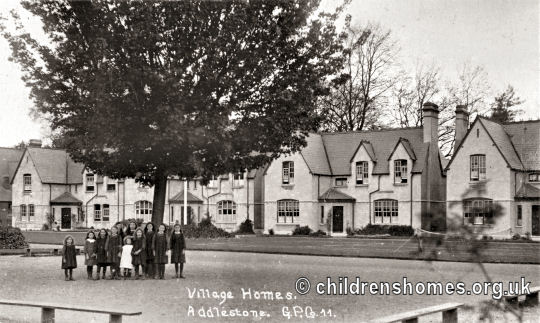
Princess Mary's Village Homes for Girls, Addlestone, c.1905. © Peter Higginbotham
The girls' daily routine began at 7.30am when they washed, dressed, performed household chores and had breakfast. After lessons in the school hall from 9.00am till noon, the girls returned to their own cottages for dinner. Afternoon lessons from 1.30pm until 4.00pm were followed by more household chores and helping to prepare the evening meal which was eaten at 5.30pm. There was then free time until bedtime at 8.30pm. The girls received weekly pocket money for satisfactory completion of their housework.
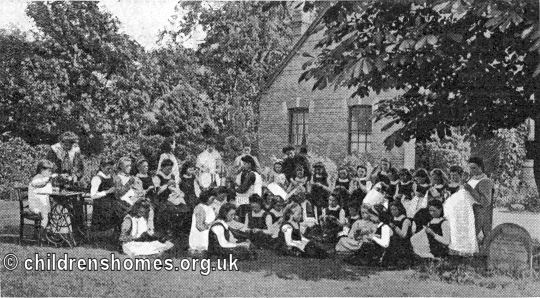
Princess Mary Village Homes for Girls, Addlestone — Afternoon tea, c.1906. © Peter Higginbotham
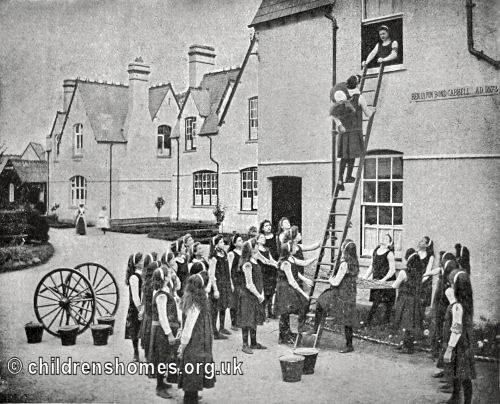
Fire drill at Princess Mary's Village Homes for Girls, Addlestone, c.1905. © Peter Higginbotham
The layout of the homes is shown on the 1936 map below.
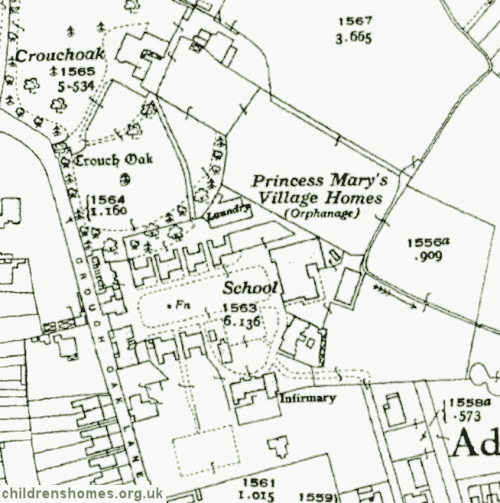
Princess Mary Village Homes Industrial School for Girls site, Addlestone, c.1936.
In 1910, an Auxiliary Home for 15 girls aged 14 or over was established in Crouch Oak House at the north of the homes. It provided a halfway house for girls about to leave the homes and enter employment. On July 10th, 1912, a property at the south of the homes, known as Homelands, was certified to house up to 26 girls who had been found to be living in a brothel or involved in prostitution or sexual abuse.
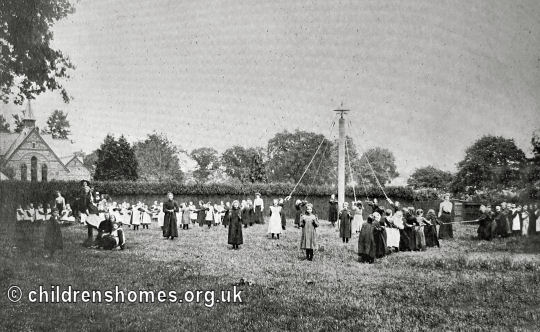
Maypole dancing at Princess Mary's Village Homes for Girls, Addlestone, c.1905. © Peter Higginbotham
By 1930, the homes had become one of the small number of Industrial Schools housing both boys and girls.
In around 1933, the site was converted to one of the new Approved Schools that replaced the former Industrial Schools and reformatories. In its new role a Junior Approved School for Girls, it initially housed up to 175 girls aged under 15.
In 1973, the school became a Community Home with Education (CHE) under the control of the Merton Borough Council.
The CHE had closed by 1980 and the buildings were then demolished. The site is now covered by modern housing.
Records
Note: many repositories impose a closure period of up to 100 years for records identifying individuals. Before travelling a long distance, always check that the records you want to consult will be available.
- Surrey History Centre, 130 Goldsworth Road, Woking, Surrey GU21 6ND. Holdings include: Minute books (1902-73); Annual reports (1883-1950); Accounts (1920-73); Registers of inmates (1870-1973, includes case histories, background notes and reports); Building plans; Photographs; Trustees handbook (1927).
- [an error occurred while processing this directive] has searchable Registers of Inmates (1870s-90s).
- Chertsey Museum, The Cedars, 33 Windsor Street, Chertsey, Surrey KT16 8AT.
Census
Bibliography
- Higginbotham, Peter Children's Homes: A History of Institutional Care for Britain s Young (2017, Pen & Sword)
Links
Except where indicated, this page () © Peter Higginbotham. Contents may not be reproduced without permission.


